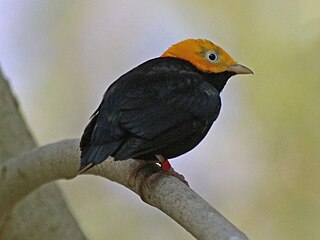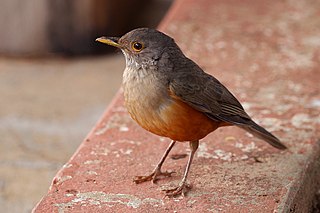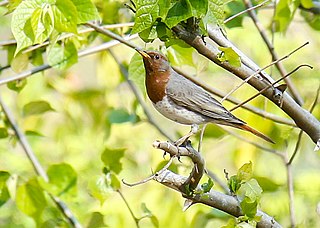
The green hermit is a large hummingbird that is a resident breeder from southern Central America south to northern South America

The white hawk is a bird of prey breeding in the tropical New World of the family Accipitridae. Though it is commonly placed in the subfamily Buteoninae, the validity of this group is doubtful and currently under review.

The rufous-breasted hermit or hairy hermit is a hummingbird that breeds from Panama south to Bolivia, and on Trinidad, Tobago and Grenada. It is a widespread and generally common species, though local populations may change in numbers and disappear altogether in marginal habitat.

The tropical parula is a small New World warbler. It breeds from southernmost Texas and northwest Mexico (Sonora) south through Central America to northern Argentina, including Trinidad and Tobago. This widespread and common species is not considered threatened by the IUCN.

The cocoa thrush is a resident breeding thrush in South America, from eastern Colombia south and east to central and eastern Brazil, as well as on the Caribbean island of Trinidad and some of the Lesser Antilles.

The spectacled thrush, bare-eyed thrush, or yellow-eyed thrush, is a resident breeding bird in the Lesser Antilles and in South America from Colombia and Venezuela south and east to northern Brazil. In Trinidad and Tobago, this thrush is also known as big-eye grieve.

The white-necked thrush is a songbird found in forest and woodland in South America. The taxonomy is potentially confusing, and it sometimes includes the members of the T. assimilis group as subspecies, in which case the "combined species" is referred to as the white-throated thrush. On the contrary, it may be split into two species, the rufous-flanked thrush and the grey-flanked thrush.

The moriche oriole is a passerine bird in the New World family Icteridae. It is unrelated to Old World orioles. It is a breeding resident in the tropics of eastern South America. This bird is noted for its close association with the palm Mauritia flexuosa.

The yellow-rumped cacique is a passerine bird in the New World family Icteridae. It breeds in much of northern South America from Panama and Trinidad south to Peru, Bolivia and central Brazil. However, they have been sighted as far north as Nayarit state in Mexico.

The yellow-chinned spinetail is a passerine bird found in the tropical New World from Trinidad and Colombia south to Argentina and Uruguay. It is a member of the South American ovenbird family Furnariidae.

The golden-headed manakin is a small passerine bird which breeds in tropical Central and South America in both wet and dry forests, secondary growth and plantations. It is a small manakin, about 9.4 centimetres (3.7 in) long. Males are entirely black apart from a golden head, yellow bill, white and red thighs and pink legs. Females and juveniles are olive-green with pink legs. At breeding time, males are involved in a cooperative lekking behaviour during which they jump, slide and dart from perch to perch. This is a fairly common species with a wide range, and the International Union for Conservation of Nature has rated its conservation status as being of "least concern".

The white-throated spadebill is a tiny passerine bird in the tyrant flycatcher family. It lives in the tropical Americas.

Platycichla is a small disputed genus of tropical South American thrushes. It contains just two species:

Manacus is a genus of passerine birds in the manakin family which are found in the forests of tropical mainland Central and South America, and on Trinidad and Tobago.

The rufous-bellied thrush is a songbird of the thrush family (Turdidae). It occurs in most of east and southeast Brazil from Maranhão south to Rio Grande do Sul states, Bolivia, Paraguay, Uruguay and central regions of Argentina.

The Philippine bulbul is a songbird species in the bulbul family, Pycnonotidae.

The Trinidad euphonia is a species of bird in the family Fringillidae. It is common in northern Colombia and northern Venezuela and uncommon to rare on the Caribbean island of Trinidad. Like all euphonias, it is small, stocky, and short-tailed; unlike some, it is sexually dimorphic. The male is glossy blue-black on the head, back, throat, and upper breast, with a bright yellow forehead and crown, and bright yellow underparts. The female is olive-green above and yellow-olive below, with a grayer patch running down the center of her breast and abdomen, and bright yellow undertail coverts. Its calls are high-pitched, plaintive whistles: the two most common are a single-pitched, double-noted "pee pee" or "tee dee", or a rising, double-noted "puwee", "cooleee" or "duu dee". Its song is a short, jumbled mix of musical and nonmusical notes.

The pale-eyed thrush is a species of bird in the family Turdidae.

The red-throated thrush is a passerine bird in the thrush family. It is sometimes regarded as one subspecies of a polytypic species, "dark-throated thrush", black-throated thrush then being the other subspecies. More recent treatments regard the two as separate species. The scientific name comes from Latin. Turdus is "thrush" and the specific ruficollis is derived from rufus', "red", and collum, "neck".

The Ecuadorian thrush is a resident bird found in western South America in western Ecuador and far northwestern Peru. It was formerly considered to be a subspecies of the spectacled thrush, Turdus nudigenis, but has a narrower eyering, and is widely separated in range.























